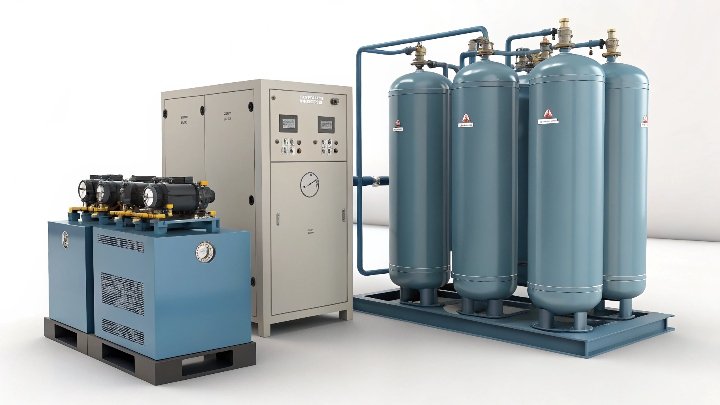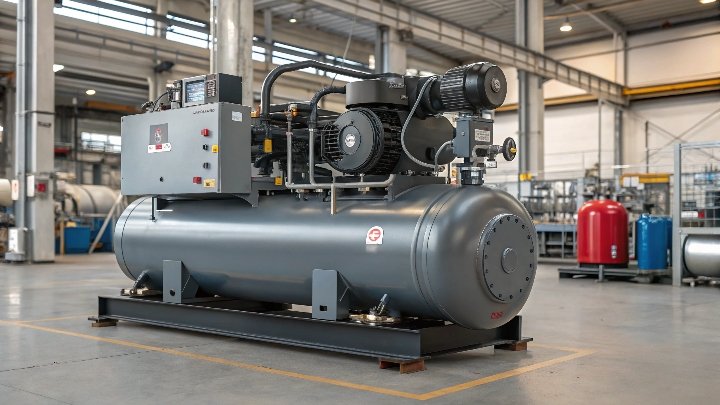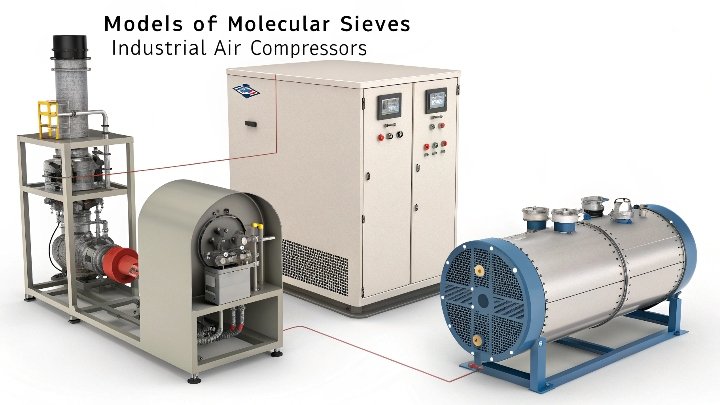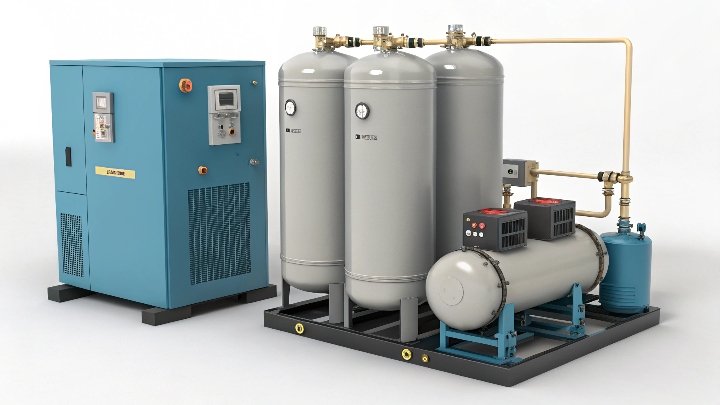I often see people struggle with moisture problems in compressed air. This can lead to equipment damage and production delays.
Molecular sieves like 3A and 4A are commonly used to solve this moisture issue. They have special pore sizes that attract water while allowing other gases to pass through.
I realized early on that removing water from compressed air is not only about product quality. It is also about extending the life of expensive equipment. That made me want to explore these tiny yet mighty beads further.
Types of Molecular Sieves Used in Air Compressor Drying?
I used to wonder which molecular sieves best handle air compressor drying. Many brands exist, and each one claims to be the best.
3A and 4A sieves are the most popular choices. Their pore sizes target water molecules, leaving other gases unblocked. This makes them perfect for air compressor applications.
A Look at 3A and 4A Sieves
I remember my first encounter with 3A and 4A sieves in an industrial setting. Someone showed me how these small pellets absorb water while ignoring larger molecules. It seemed magical. I then understood that the effectiveness of a sieve depends on its pore size.
When I talk about 3A sieves, I refer to those with a pore size of about 3 angstroms. This specific size allows water molecules to enter but keeps out bigger molecules like hydrocarbons. On the other hand, 4A sieves have slightly larger pores, around 4 angstroms. This lets them capture water and other small molecules, though water remains their primary target in air compressor systems.
I learned that 3A is best for applications where I want to selectively remove moisture while leaving larger molecules. 4A can remove water and can also adsorb certain other small molecules. In the world of air compressors, 3A and 4A each have strengths, but both excel at preventing moisture problems. I once worked on a system that used 4A sieves, and I was impressed by how quickly and effectively they dried the air.
Although I tend to focus on 3A and 4A, there are other types, such as 5A or 13X. But for most air compression tasks, 3A and 4A are enough. Their performance is great, and they are widely available. These sieves also have strong mechanical stability, which helps them endure the pressure swings in many air compressor processes.
Below is a quick comparison of 3A and 4A:
| Sieve Type | Pore Size | Main Application | Advantages |
|---|---|---|---|
| 3A | ~3 Å | Selective moisture removal | Prevents co-adsorption of large molecules |
| 4A | ~4 Å | Moisture removal and some small molecules | Broad adsorption capacity, widely used |
I find it fascinating how these pore sizes act like gates. The 3A gate is strict, only letting water in. The 4A gate is a bit more lenient. When I saw these beads under a microscope, it struck me that the design is brilliant. It is precise yet simple. Water molecules enter, but bigger molecules stay out.
In many of my projects, the correct choice came down to the final specs. If I only cared about water, 3A was enough. If I wanted a bit more versatility, I picked 4A. Knowing what your system needs is key, and a little planning goes a long way.
How Molecular Sieves Work to Remove Moisture in Air Compressors?
I remember when I first tried to explain how these beads work. It sounded like magic. But it is actually basic physics and chemistry.
They pull in water molecules by creating a stronger attraction than the water’s bond with the air. This ensures the air stays dry and clean.
The Science Behind Adsorption
Let me break down how these sieves operate. It all starts with their porous structure. Each bead has countless channels that are small enough to trap water molecules. This process is called adsorption, not absorption. Adsorption happens on the surface, while absorption is more like a sponge soaking liquid into its bulk.
When compressed air passes through a bed of molecular sieve beads, water molecules are drawn in by electrostatic forces. I think of the sieve like a magnet for water. These forces attract the water strongly, so the air that exits has very little moisture. This dryness helps protect tools, pipelines, and end products. I have seen entire production lines save money on maintenance because they avoided rust and product contamination.
Another key point is regeneration. Once a sieve bed is loaded with water, it needs to be dried out. The typical regeneration method involves applying heat or vacuum to drive off the adsorbed water. I have witnessed systems where they alternate between two sieve beds. One bed dries the air while the other regenerates. This switch keeps everything running smoothly.
I once managed a system where we used heated regeneration at a precise temperature. If we did not reach that temperature, the sieves did not fully release all the water. This lowered the system’s overall adsorption capacity. It taught me that proper regeneration is just as important as selecting the right sieve.
The difference between 3A and 4A in actual operation can be subtle. Both remove water, but 4A can also capture some other small molecules. In an air compressor system, this is not always a drawback. However, if you have valuable compounds in the stream that you want to preserve, 3A might be the safer option. For many general-purpose compressed air systems, 4A offers a good balance of moisture removal and overall performance.
Adsorption efficiency also depends on process conditions, such as pressure and temperature. Hotter air or higher pressure can change how much water the beads can hold. That is why I pay close attention to operating parameters. If my client wants maximum moisture control, I advise them to check if they can cool the air first or manage the pressure in a way that helps the sieve perform better.
I find that these basic principles remain the same across many industries. Whether I am working with a small workshop or a giant factory, the logic is identical. Water molecules get trapped. The air stays dry. Eventually, the sieve is regenerated. It is an elegant cycle that keeps everything moving.
Benefits and Applications of Molecular Sieves in Air Compression Systems?
I always tell people that these sieves do more than just remove water. They offer reliability and efficiency gains as well.
They minimize corrosion, extend equipment life, and increase productivity. This makes them essential in places like manufacturing plants and food processing facilities.
Exploring the Real-World Impact
I have worked in different facilities, and I often see how molecular sieves transform daily operations. In a basic compressed air line without sieves, moisture causes rust inside pipes. It also leads to water accumulating in the lines. That water can harm sensitive tools and ruin final products. When I install a molecular sieve dryer, the difference is noticeable. The air lines run smoothly. Maintenance intervals get longer. Production lines face fewer disruptions.
Another advantage is product quality. In food processing, for example, moisture can breed bacteria or cause clumping in powders. By using a molecular sieve to keep the air dry, I reduce the risk of contamination. The packaging lines stay clean, and products maintain their texture. I witnessed one client in the dairy industry save thousands of dollars each year because they had fewer product spoilage incidents.
Let me also mention how performance ties in with energy efficiency. Dry air is less likely to condense in piping systems. This means better airflow and lower pressure drops. When the pressure drop is lower, the compressor uses less energy to maintain the desired pressure level. In one facility where I worked, we saw a clear drop in energy costs after adding a molecular sieve dryer to the system. It was a big improvement for the bottom line.
Applications extend to electronics manufacturing too. Moisture is a huge concern there because water can cause short circuits or damage to sensitive components. By ensuring the air is dry, we protect circuit boards and other parts during production. I have heard from colleagues who design systems for semiconductor plants that dryness is crucial. A small amount of water can ruin an entire batch of chips, so molecular sieve dryers are non-negotiable.
I recall a conversation with a food packaging engineer who said that using molecular sieves was a game-changer. Their equipment lasted longer. The final product stayed fresh. Their entire line became more efficient. This highlights how wide the impact can be. It is not just about dryness; it is about consistency, cost savings, and product integrity.
Furthermore, these sieves are compact and easy to integrate. Many dryer units come pre-packaged with molecular sieve beds and built-in regeneration systems. Installing them is straightforward, and maintenance is not too complicated, given the extended lifetime of modern sieves. I check them periodically for contamination or attrition (the physical breakdown of the beads). Aside from that, they usually run without major issues.
I view molecular sieves as a hidden hero of industrial processes. They are small, and people often ignore them. But they work quietly to maintain quality, reduce costs, and keep systems running. That is the real magic behind them. I have seen many technologies come and go, but molecular sieves remain a staple in air compressor applications for good reason.
Conclusion
I see molecular sieves as a key part of air compressor drying. They solve moisture problems and make systems efficient.






